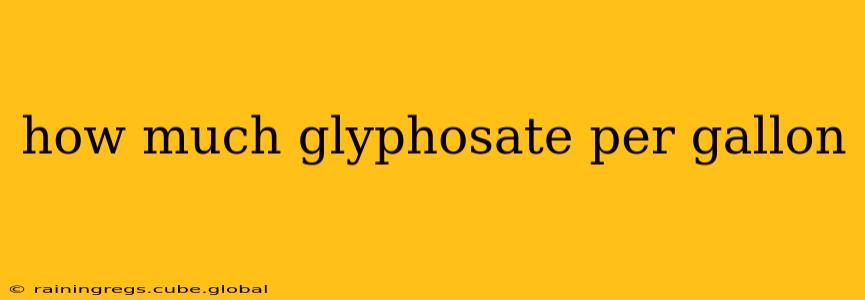How Much Glyphosate Per Gallon? A Comprehensive Guide to Herbicide Application
Determining the correct amount of glyphosate per gallon is crucial for effective weed control while minimizing environmental impact. The concentration varies greatly depending on the specific product, the target weed species, and the application method. There's no single answer to "how much glyphosate per gallon," but this guide will clarify the factors involved and help you determine the appropriate concentration for your needs.
Understanding Glyphosate Products:
Glyphosate is the active ingredient in many popular herbicides, sold under various brand names like Roundup, KleenUp, and others. Each product will have a specific concentration of glyphosate, usually expressed as a percentage (e.g., 41% glyphosate). This percentage is vital in calculating the correct application rate. Always check the product label for the precise concentration and application instructions.
Factors Affecting Glyphosate Concentration:
Several factors influence the appropriate glyphosate concentration per gallon:
- Product Concentration: As mentioned, the percentage of glyphosate in the product dictates the amount needed. A higher concentration requires less product to achieve the desired strength.
- Target Weed Species: Some weeds are more resistant than others. Tougher weeds may necessitate a higher concentration of glyphosate. Consult the product label for specific recommendations for different weed types.
- Application Method: Different application methods (e.g., spraying, spot treatment) require varying concentrations. Spraying a wide area typically uses a lower concentration than spot treating stubborn weeds.
- Weed Size and Density: Larger, more established weeds may benefit from a higher glyphosate concentration. Similarly, densely populated weed areas may require a higher concentration for effective control.
- Environmental Conditions: Factors like temperature, humidity, and sunlight can affect glyphosate effectiveness. Extreme temperatures can reduce the effectiveness of the herbicide. Check the product label for guidance on optimal application conditions.
Calculating the Correct Concentration:
The product label will provide the recommended application rate, usually expressed as ounces or pounds of product per gallon of water or per acre. Carefully follow these instructions. Here's a general example:
Let's say your glyphosate product is 41% glyphosate and the label recommends applying 2 ounces of product per gallon of water. This means you'll add 2 ounces of the 41% glyphosate concentrate to 1 gallon of water. It's essential to use accurate measuring tools for consistent results.
Safety Precautions:
- Always read and follow the instructions on the product label. This is crucial for safe and effective application.
- Wear appropriate personal protective equipment (PPE), including gloves, eye protection, and long sleeves, when handling glyphosate.
- Avoid spraying on windy days to prevent drift onto non-target plants.
- Store glyphosate properly in a secure location, out of reach of children and pets.
Frequently Asked Questions (FAQs):
Can I mix glyphosate with other herbicides?
The product label will indicate whether the glyphosate product is compatible with other herbicides. Mixing incompatible products can result in reduced effectiveness or even harmful reactions. Always check the label before mixing.
How long does it take for glyphosate to work?
The time it takes for glyphosate to show effects depends on several factors, including environmental conditions and the target weed. It usually takes several days to a couple of weeks for visible results. Complete weed death may take longer.
Is glyphosate safe for the environment?
The environmental impact of glyphosate is a subject of ongoing debate. While generally considered relatively safe when used as directed, it's important to follow application instructions carefully to minimize environmental harm. Non-target plants may be affected.
What should I do if I accidentally ingest or spill glyphosate?
Immediately contact poison control or your doctor if you accidentally ingest or spill glyphosate. Have the product label readily available to provide information to medical professionals.
This information is for educational purposes only and should not be considered professional advice. Always consult the product label and seek expert advice when necessary. Proper handling and application of glyphosate are crucial for safe and effective weed control.
